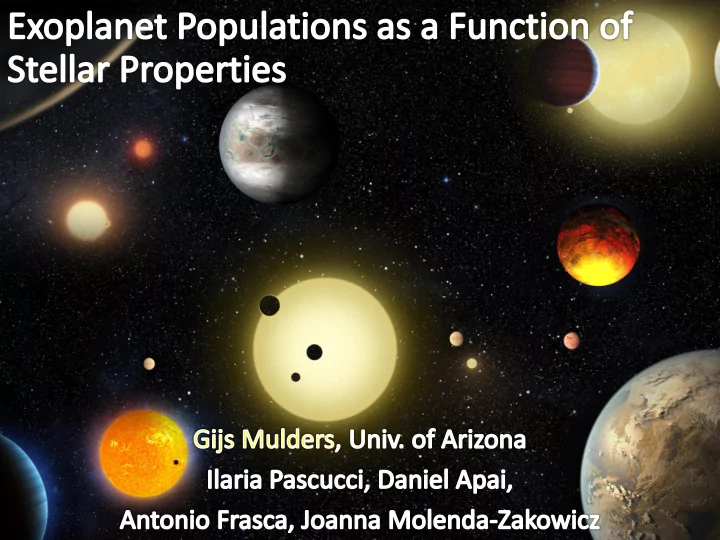

NASA Ames
Kepler Mission Goals • “Determine the percentage of terrestrial and larger planets that are in or near the habitable zone of a wide variety of stars” • … • “Determine the properties of those stars that harbor planetary systems .”
Kepler: exoplanet statistics Earth-sized habitable zone planet around sun-like star: • 0.5 % transit probability • ~10% (?) detection efficiency • 10% planet occurrence rate Need to monitor 20,000 stars to find a single planet!
NASA Ames
Planet occurrence rate • Average number of planets per star (< fraction of stars with planets) ~1 planet per star ~10% stars have earth-sized planet in the habitable zone. Why occurrence rate? – Exoplanet discovery mission yield – Planet Formation /Evolution
Why Exoplanet Host Star Properties?
Why Exoplanet Host Star Properties?
Why Exoplanet Host Star Properties? Stellar-mass dependencies can constrain planet formation mechanisms Fischer & Valenti 2005 More giant planets around metal-rich stars
Why Exoplanet Host Star Properties? Stellar-mass dependencies can constrain planet formation mechanisms Johnson et al. 2007 More giant planets around more massive stars
Kepler: Most planets are small Fressin et al. 2013. RV: Howard et al. 2010
Talk Outline 1. Planet Population 2. Stellar mass 3. Stellar metallicity (LAMOST!)
Kepler: Exoplanet Transits
Planet population: Occurrence rate 1. Stars 2. Planets 3. Detection efficiency & Transit probability
1. Stars Huber et al. 2014, Dressing & Charbonneau 2013
2. Planets
S/N ratio: 3. Detection efficiency transit depth stellar noise
Geometric 3. Detection efficiency Transit Probability
1. Stars Huber et al. 2014, Dressing & Charbonneau 2013
M dwarfs have more planets Mulders 2017 under review
More small planets, fewer giants 4x Mulders et al. 2015b 2x
Comparison with disk solids Mulders et al. 2015c. Disk mass: Pascucci et al. 2016
Observed Sunlike Star Protoplanetary Disk with Kepler Planet Migration Red Dwarf
Dependence on Metallicity
Host Star Metallicity (CPS) Bucchave et al. 2014 Trend vanishes!
No Trend Metallicity Dependence of sub-Neptunes RV: Sousa+ 2008 Winn+ 2017 Buchhave+ 2014 Dawson+ 2015 Mulders+ 2016 Dong+ 2017 Wang&Fischer 2015 Trend Strong RV: Giant planets
LAMOST Stellar Metallicities [Fe/H] from ROTFIT pipeline (Frasca et al. 2016) • 51,385 stars • 20,863 MS stars • 665 planet hosts
Metallicity versus orbital period Mulders et al. 2016
Metallicity versus orbital period Mulders et al. 2016, also Dong et al. 2017
Small Impact on Planet population 30% 90% 10% Mulders et al. 2016
Small Impact on Planet population Mulders et al. 2016, Adibekyan et al. 2016 Trend here? (1.5 sigma) 3 sigma? -> 100,000 stars DR3/4/5+
Future Outlook • Transit surveys to study exoplanet populations (Kepler, K2, TESS) • Stellar characterization needed for determining planet parameters • Stellar parameters of non-planet hosts to calculate planet occurrence rates • LAMOST provides additional information (metallicity) not provided by other surveys.
Recommend
More recommend